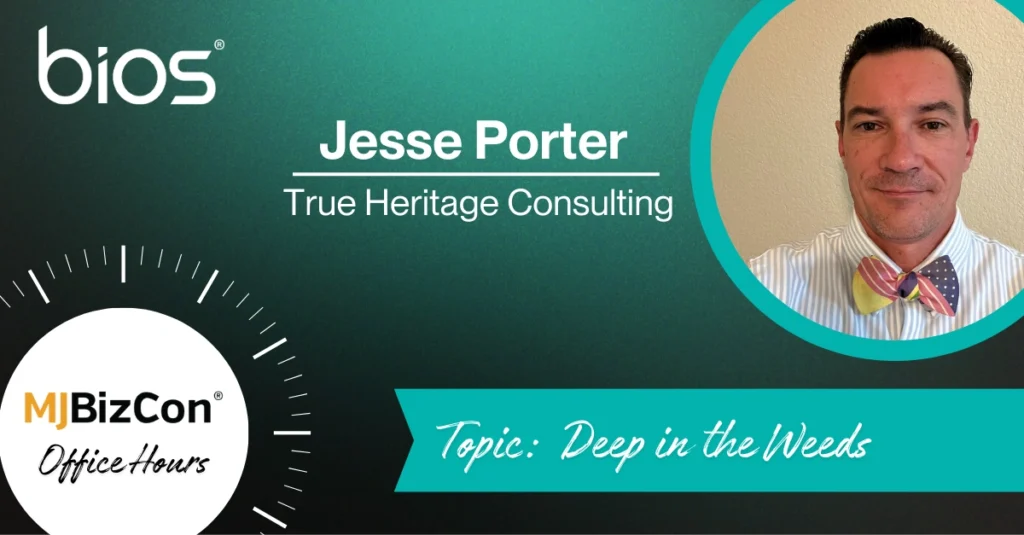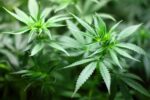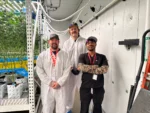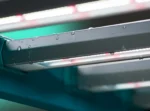This founder helps cultivators big and small by recommending low-cost, high-impact solutions with his bag of tricks, two decades of know-how, and a data-driven approach to growing wickedly good cannabis.

When the all-in-one cannabis consultant Jesse Porter of True Heritage Consulting—THC for short—comes to the table to discuss how to improve a cannabis grow, he’s often playing the role of the translator.
“I sit down with a CEO who’s talking about ROI and EBITDA,” he said, “an engineer who’s talking about thermodynamics and psychometrics, and a cultivator who’s talking about phenotypic expression. I am receptive to the input from those fields. As a consultant I always want to find the common language for realistic conversations to make sure these people make the most-informed decisions, and that no one gets ostracized.”
Good thing he’s a polyglot of pot. In his twenty years in the industry, Jesse has worked every job under the sun, from trimming flower down in the grow room to running large-scale dispensaries and cultivation facilities. Hydroponics, seeds, clones—he’s done it all. He even owns and operates his own large-scale outdoor farm in California.
What’s something you wish the average commercial cultivator understood about how lighting impacts HVAC?
At a cultivation facility, HVAC, lighting, and irrigation are all part of the same ecosystem, all variables in the same formula. But in order to achieve the best conditions for your plants, the numbers you gather around temperature, humidity, light intensity, and more must reflect reality. In Jesse’s experience, too many of them don’t.
“The grower thinks, ‘Oh, cool, we’re doing great. We’re at 80 degrees in here.” Turns out you might have low air flow, and the plant temperature is actually 89 degrees, which is far too high. ‘Oh, my lights are working great. They’re running at 100 percent!’ Well, what’s the PPFD [photosynthetic photon flux density]? What’s the actual lighting intensity at the canopy?”
Small, focused adjustments to how you gather or corroborate data resonate across the business. A more accurate gauge of temperature at plant level, for example, will mean you more precisely manage airflow and cooling, ultimately getting a higher performance and phenotypic expression from your plants. Rethinking the placement of your fans or your supply and return configurations can similarly have dramatic effects on the efficiency and efficacy of your grow.
Ask yourself one question to kick-start this new way of thinking: when was the last time you calibrated your sensors? “No wonder you’re at 89 degrees when you should be at 80,” Jesse said. “No wonder your plants are unhappy. Your sensors are telling you everything’s good!”
What’s in Jesse’s toolbox?
For those facilities who can’t identify the exact obstacle to their success, True Heritage Consulting offers a ten-step site assessment. To perform this comprehensive evaluation, Jesse brings with him a whole host of powerful equipment:
+ Hot-wire anemometer: measures airflow across the canopy.
+ Forward-looking infrared gun: measures temperature at surface level.
+ Light intensity meter: measures PAR-specific light falling on plants.
+ Tensiometer: measures accessible water at the substrate.
When Jesse first started performing these assessments back in 2016, he was going in blind, but it wasn’t long before he realized that data collection and analysis was crucial to providing valuable insights and impartial recommendations to his clients. After all, you can’t argue with hard numbers.
“Your plants are growing every second of every day,” Jesse said. “I don’t want to waste any of those seconds with nonsense.”
Is racking underutilized or underappreciated cannabis cultivation?
As integral as HVAC, lighting, and irrigation are to your facility, did you know that racking can act as a blueprint for how to invest in that critical tech?
“If you figure out your racking layout early on, you can really say, ‘Oh, cool, this room, these genetics, this much airflow—this is exactly what we need.’”
Because racking dictates how many square feet of canopy you’ll have, it then dictates your lighting rig, fertigation, media choices, and more. That way, scaling up or moving to a multi-tier racking system becomes a much easier undertaking when the time comes. It’s just a matter of multiplying the numbers you have to reach the numbers you want.
“Build the two rooms that get the performance you want per square foot, get that cash flow, and then build the next two rooms instead of building six bad rooms and hoping for the best.”
You host a podcast called Ask the Growbot. What’s that all about?
If you’re hunting for a new cannabis podcast, don’t miss Ask the Growbot, where Jesse and a featured cannabis expert plug difficult questions into a generative AI and talk through the results.
“Sometimes it’s spot on,” he said, laughing, “and sometimes it misses the mark pretty tremendously.”
So far, the show is a must-listen for anyone who wants high-level scientific conversations about cannabis with seasoned cultivators and engineers like Gretchen Schimelpfenig from Energy Resource Integration and Adrian Giovenco from Inspire Transpiration Solutions. Jesse hopes that listeners will see Ask the Growbot as both a path into an otherwise walled-off industry of a thousand little niches, and as a vetting ground for opportunities to partner with real experts with real knowledge.
“It’s honest, genuine, and unpredictable. You’ve got these affable personalities, you get to see how these salespeople or solutions providers deal with problems, deal with contention from the customers, and what they actually bring to the table.”
“BIOS is a great example of a team that has a diverse background in cannabis experience,” Jesse said. “When you buy lights from them, they want to talk about some other factors in the space: What are you doing for air flow? How can you water? What’s your defoliation process like?”



